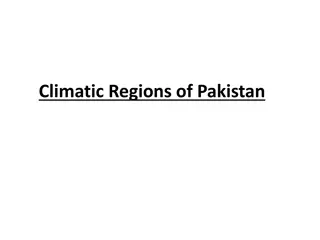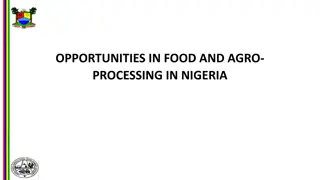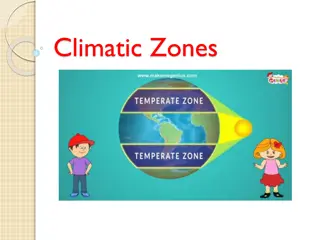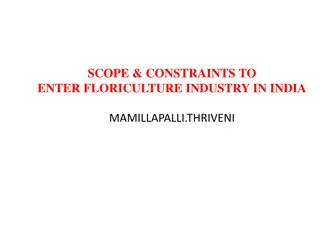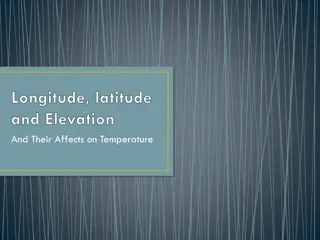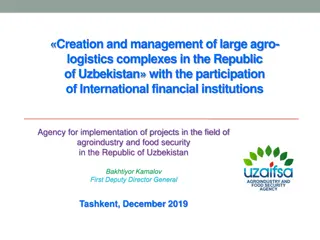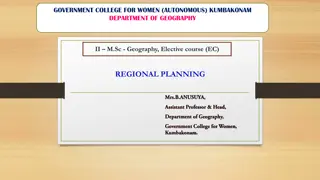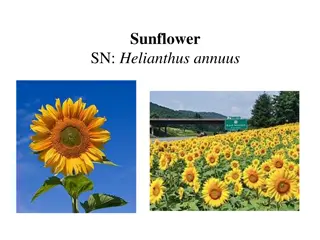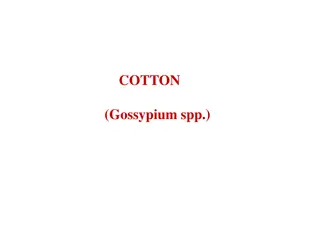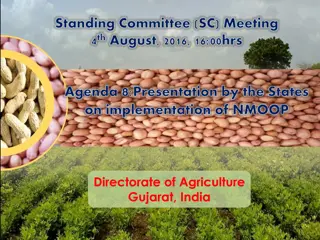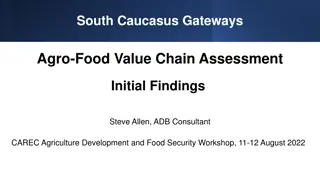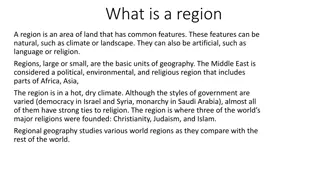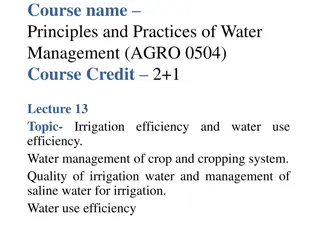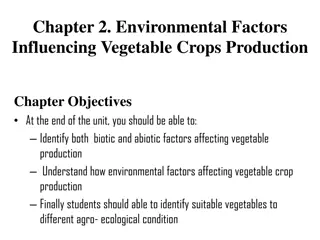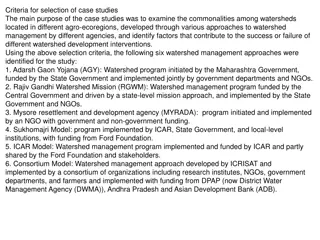Agro-Climatic Regions of India: Overview and Objectives
Explore the delineation and characteristics of agro-climatic regions in India, based on geo-climatic and socio-economic variations. Learn about the objectives focusing on agricultural production, farm income, rural employment, and regional development.
Download Presentation

Please find below an Image/Link to download the presentation.
The content on the website is provided AS IS for your information and personal use only. It may not be sold, licensed, or shared on other websites without obtaining consent from the author. Download presentation by click this link. If you encounter any issues during the download, it is possible that the publisher has removed the file from their server.
E N D
Presentation Transcript
Agro-Climatic Regions of India By Dr. Nuruzzaman Kasemi Associate Professor Department of Geography Raiganj University
Agricultural regionalisation Differentiated segment of earth surface (Whittlesry, 1935) Uninterrupted area in respect of agricultural land, practices and pattern. Distinctive form of agriculture Dynamic concept 9/12/2020 Raiganj University, Dept. of Geography 2
Agricultural region Characteristics Location Transitional boundaries Formal or functional Hierarchically arranged Delineation of agricultural region Empirical technique Single-element technique Multi-element or statistical technique 1. Cropping pattern, concentration, diversification 2. Crop combination 3. Regional pattern of agricultural productivity 4. Quantative-cum-Qualitative 9/12/2020 Raiganj University, Dept. of Geography 3
Agro-Climatic Regions of India The Planning Commission and National Remote Sensing Agency (NRSA) On the basis of geo-climatic, socio-economic and agricultural practices variations In 1988 the Planning Commission came up with a growth strategy based on a holistic approach of area planning for long-term resource efficiency and sustainability. 15 Agro-climatic regions 9/12/2020 Raiganj University, Dept. of Geography 4
Objectives of Agro-Climatic Regions Agricultural production Farm income More rural employment Available irrigation water Regional inequalities and development of agriculture 9/12/2020 Raiganj University, Dept. of Geography 5
Agro-Climatic Regions of India Zone 1- Western Himalayan Region: Jammu and Kashmir, Uttar Pradesh Zone 2 - Eastern Himalayan Region: Assam, Sikkim, West Bengal and all North-Eastern states Zone 3 - Lower Gangetic Plains Region: West Bengal Zone 4 - Middle Gangetic Plains Region: Uttar Pradesh, Bihar Zone 5 - Upper Gangetic Plains Region: Uttar Pradesh Zone 9/12/2020 Raiganj University, Dept. of Geography 6
Contd. 6 - Trans-Gangetic Plains Region: Punjab, Haryana, Delhi and Rajasthan Zone 7 - Eastern Plateau and Hills Region: Maharashtra, Uttar Pradesh, Orissa and West Bengal Zone 8 - Central Plateau and Hills Region: MP, Rajasthan, Uttar Pradesh Zone 9 - Western Plateau and Hills Region: Maharashtra, Madhya Pradesh and Rajasthan Zone 10 - Southern Plateau and Hills Region: Andhra Pradesh, Karnataka, Tamil Nadu 9/12/2020 Raiganj University, Dept. of Geography 7
Contd. Zone 11 - East Coast Plains and Hills Region: Orissa, Andhra Pradesh, Tamil Nadu and Pondicherry Zone 12 - West Coast Plains and Ghat Region: Tamil Nadu, Kerala, Goa, Karnataka, Maharashtra Zone 13 - Gujarat Plains and Hills Region: Gujarat Zone 14 - Western Dry Region: Rajasthan Zone 15 - The Islands Region: Andaman and Nicobar, Lakshadweep. 9/12/2020 Raiganj University, Dept. of Geography 8
9/12/2020 Raiganj University, Dept. of Geography 9
Zone 1- Western Himalayan Region Great variation in relief. July average temperature 5 C-30 C January temperature 0 C to -4 C Average annual rainfall is 150 cms Valleys and duns have thick layers of alluvium while hill slopes have thin brown hilly soils. Number of perennial streams due to high rainfall and snow- covered mountain peaks Yamuna, Jhelum, Chenab, Satluj and Beas etc.) (Ganga, 9/12/2020 Raiganj University, Dept. of Geography 10
Contd. Rice is the main crop of this region which is cultivated in terraced fields along the hill slopes. Maize, wheat, potato, barley are other important crops. The horticulture of the region is obsessed with the problems of financial crisis, varieties of plants and high post-harvest losses (about 20% in packing, storage, marketing and processing). A more rational land use planning is required for the region. Land suitable for agriculture, horticulture, pasture, forestry lack of improved 9/12/2020 Raiganj University, Dept. of Geography 11
Zone 2 - Eastern Himalayan Region The Eastern Himalayan region consists of Sikkim, Darjeeling Bengal), Arunachal Pradesh, Assam hills, Nagaland, Meghalaya, Manipur, Mizoram and Tripura. Rugged topography, forest cover and sub-humid climate (rainfall over 200 cm; temperature July January 11 C-24 C). The soil is brownish, thick layered and less fertile. Shifting cultivation (Jhum) is practised. area (West 25 C-33 C, 9/12/2020 Raiganj University, Dept. of Geography 12
Zone 3 - Lower Gangetic Plains Region This region spreads over eastern Bihar, West Bengal and Assam valley 100 cm-200 cm, July month varies from 26 C- 41 C and for January month 9 C-240C Adequate storage of groundwater Rice is the main crop Jute, maize, potato, and pulses are other important crops. 9/12/2020 Raiganj University, Dept. of Geography 13
Zone 4 - Middle Gangetic Plains Region Eastern Uttar Pradesh Chotanagpur plateau). 26 C- 4I C & 9 C-24 C, 100 cm and 200 cm Rice, maize, millets in, kharif, wheat, gram, barley, peas, mustard and potato in rabi are important crops Modern market oriented agriculture and Bihar (except 9/12/2020 Raiganj University, Dept. of Geography 14
Zone 5 - Upper Gangetic Plains Region Central and western parts of Uttar Pradesh Sub-humid continental, 26 -41 C & 7 - 23 C , 75 cm- 150 cm, sandy loam. Needs special focus on dairy development and horticulture Rice-potato- wheat-moong sunflower, and potato + mustard; Improving irrigation management and sugarcane , system and water 9/12/2020 Raiganj University, Dept. of Geography 15
Zone 6 - Trans-Gangetic Plains Region Punjab, Haryana, Ganganagar dis-trict of Rajasthan. Semiarid, 26 C and 42 C & 7 C to 22 C, 70 cm and 125 cm. Wheat, sugarcane, cotton, rice, gram, maize, millets, pulses and oilseeds etc. Credit of introducing Green Revolution Problem of water logging, salinity, alkalinity, soil erosion and falling water table Delhi, Chandigarh and 9/12/2020 Raiganj University, Dept. of Geography 16
Zone 7 - Eastern Plateau and Hills Region Chotanagpur plateau Rajmahal hills, Chhattisgarh plains and Dandakaranya 26 C-34 C & 10 C-27 C, 80 cm-150 cm, patches of laterites and alluviums Deficient in water resources Rice, millets, maize, oilseeds, ragi, gram and potato. 9/12/2020 Raiganj University, Dept. of Geography 17
Zone 8 - Central Plateau and Hills Region Bundelkhand, Baghelkhand, Bhander plateau, Malwa plateau and Vindhyachal hills Sub-humid, 26 C-40 C & 7 C-24 C, 50 cm- 100 cm , mixed red, yellow and black growing Millets, gram, barley, wheat, cotton, sunflower, etc. Dearth of water resources 9/12/2020 Raiganj University, Dept. of Geography 18
Zone 9 - Western Plateau and Hills Region Southern part of Malwa plateau and Deccan plateau (Maharashtra). 24 C-41 C & 6 C- 23 C, 25 cm-75 cm. Jowar, cotton, sugarcane, rice, bajra, wheat, gram, pulses, potato, groundnut and oilseeds are the principal crops. The area is known for its oranges, grapes and bananas. 9/12/2020 Raiganj University, Dept. of Geography 19
Zone 10 - Southern Plateau and Hills Region Maharashtra, Karnataka, western Andhra Pradesh and northern Tamil Nadu. Semi-arid with only 50 per cent of area cultivated, 26 C to 42 C & 13 C-21 C, 50 cm-100 cm. Millets predominate. Coffee, tea, cardamom and spices 9/12/2020 Raiganj University, Dept. of Geography 20
Zone 11 - East Coast Plains and Hills Region Coromandel and Northern Circar coasts Sub-humid maritime, 26 C-32 C & 20 C-29 C, 75 cm-150 cm, alluvial, loam and clay facing the menacing problem of alkalinity Rice, jute, tobacco, sugarcane, maize, millets, groundnut and oilseeds Problems of water logging and alkalinity. 9/12/2020 Raiganj University, Dept. of Geography 21
Zone 12 - West Coast Plains and Ghats Region Malabar and Konkan coasts and the Sahyadris and is covered by laterite and coastal alluvials. 200 cm, 26 C-32 C and 19 C-28 C Rice, coconut, oilseeds, millets, pulses and cotton are the main crops Famous for plantation crops and spices which are raised along the hill slopes of the Ghats. sugarcane, 9/12/2020 Raiganj University, Dept. of Geography 22
Zone 13 - Gujarat Plains and Hills Region Kathiawar and fertile valleys of Mahi and Sabarmati rivers Arid an semi-arid region, 50 cm-100 cm, 26 C- 42 C and 13 C-29 C, regur, red and yellow & alluvium soil Groundnut, cotton, rice, millets, oilseeds, wheat and tobacco are the main crops Canal and ground water management, rain water harvesting and management, dry land farming 9/12/2020 Raiganj University, Dept. of Geography 23
Zone 14 - Western Dry Region Western Rajasthan west of the Aravallis Hot sandy desert, 25 cm, high evaporation, 28 C- 45 C and 5 C-22 C, absence of perennial rivers, and scanty vegetation. Bajra, jowar, and moth are main crops of kharif and wheat and gram in rabi. Livestock contributes greatly in desert ecology 9/12/2020 Raiganj University, Dept. of Geography 24
Zone 15 - The Islands Region Andaman-Nicobar and Lakshadweep 300 cm, 30 C and 25 C, sandy loamy soil Rice, maize, millets, pulses, areca nut, turmeric and cassava. Nearly half of the area is under coconut. 9/12/2020 Raiganj University, Dept. of Geography 25
Conclusions The ACRP approach presented the evolution of an innovative planning exercise encompassing several challenges such as geographical units of disaggregation. ACRP can progress steadily beyond its present status of an experimental exercise provided it makes judicious use of the links with the implementing agencies and rapport with the state governments. 9/12/2020 Raiganj University, Dept. of Geography 26
References http://mowr.gov.in/agro-climatic-zones http://epgp.inflibnet.ac.in/epgpdata/uploads/ep gp_content/S000017GE/P001699/M020287/ET/149 6119535Agro-climaticzones(2.pdf 9/12/2020 Raiganj University, Dept. of Geography 27


